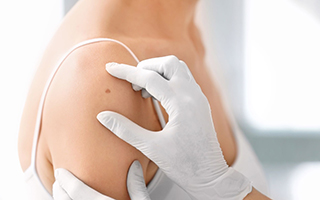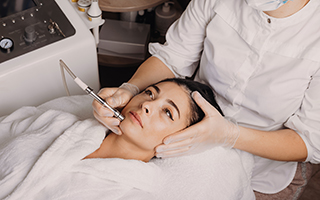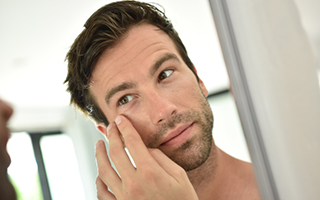Folliculitis
Relief for Irritated Hair Follicles in Bryn Mawr, Newtown Square, Philadelphia, and the Main Line
- Home
- Medical Dermatology
- DERMATOLOGY CONDITIONS
- Folliculitis
It’s possible that sudden acne-like breakouts on your skin are not pimples, but signs of folliculitis. Bryn Mawr Skin & Cancer Institute helps patients to identify and treat this common dermatological condition, which affects the hair follicles and is frequently referred to as “barber’s itch,” “hot tub rash,” razor bumps/burn, and shaving rash. While the condition isn’t life-threatening, and patients can often treat it on their own, it may become itchy, painful, or unsightly. More severe cases can impact quality of life, and patients may need professional treatment options.
Bryn Mawr Skin & Cancer Institute uses the safest and most effective methods available to treat folliculitis. To schedule an appointment, Please BOOK ONLINE, call 610.525.5028, or Contact Us.
What Causes Folliculitis?
Folliculitis is most often caused by chronic irritation to hair follicles. Daily shaving, chronic rubbing by clothing or workout equipment, and physical manipulation are common causes of inflammatory folliculitis. The bacteria staphylococcus aureus can enter the hair follicles, creating a staph infection.
The infected follicles will appear as red, pus-filled bumps with mild to moderate discomfort and/or itching. A common vacation condition is referred to as “hot tub folliculitis.” This is caused by the bacteria pseudomonas aeruginosa, which grows in the warm hot tub water. There have also been outbreaks in water parks.
What Are the Symptoms of Folliculitis?
Since we have hair covering most of our body, this disorder can develop on any area—with the exception of the palms of our hands and soles of our feet. It occurs most often on the face, upper back, arms, neck, thighs, lower legs, buttocks, and armpits. Patients who have folliculitis may experience irritation, itching, and pain. If the condition is mild, patients may not even know they have it until they see it.

Meet Our Dermatologists &
Certified Physician Assistants
Our board-certified dermatologists & PA-Cs are dedicated to detecting and treating skin cancers. We treat the full spectrum of skin diseases. Our Mohs and Plastic Surgery practices are integrated, and offer patients the most advanced skin cancer treatment, delivering superior outcomes.
What Are the Different Types of Folliculitis?
There are two main categories of folliculitis: superficial, which occurs when the follicle is only partially damaged, and deep, when the entire follicle is damaged.
The superficial type is more common than the deep type. Most people who shave experience this at some point in their lives. Deep folliculitis may develop into painful boils (furuncles and carbuncles). Incision and drainage of the involved area by a dermatologist may be necessary when this occurs.
What Are the Risk Factors for Folliculitis?
Chronic irritation to the hair follicles is the biggest risk factor for folliculitis. Recommendations to avoid the condition include wearing loose-fitting clothing, showering right after working out, using “bump fighter” razors and shaving cream, avoiding long-term use of topical steroids, staying out of public hot tubs and water parks, and not cutting curly hair too close to the skin. Cutting curly hair too close to the skin leaves the skin predisposed to ingrown hairs, which create inflammation. This condition is referred to as pseudofolliculitis barbae.
Treatment Options for Folliculitis
Chronic irritation to the hair follicles is the biggest risk factor for folliculitis. Recommendations to avoid the condition include wearing loose-fitting clothing, showering right after working out, using “bump fighter” razors and shaving cream, avoiding long-term use of topical steroids, staying out of public hot tubs and water parks, and not cutting curly hair too close to the skin. Cutting curly hair too close to the skin leaves the skin predisposed to ingrown hairs, which create inflammation. This condition is referred to as pseudofolliculitis barbae
Diagnosis is most often made by clinical presentation. If bacterial infection is suspected, a bacterial culture will be performed. Treatment options include avoiding chronic irritation to the follicles, as noted previously. Topical and oral antibiotics and a topical steroid may be prescribed. Incision and drainage may be necessary for more severe cases. Compresses with diluted white vinegar (one part white vinegar to four parts of water) and witch hazel application can be done at home to help heal the involved areas.
Care for Many Skin Conditions
Many rashes share common symptoms: redness, itching, discomfort, and pain. Our dermatologists can diagnose the problem, from poison ivy to hives, so the most appropriate treatment can be applied to bring relief.
For more information on folliculitis in Bryn Mawr, Newtown Square, and Philadelphia, contact Bryn Mawr Skin & Cancer Institute. Please BOOK ONLINE, call 610.525.5028, or Contact Us.

























